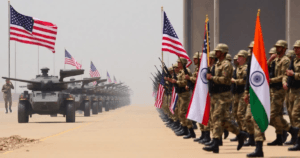U.S.-India Military Drill 2025: Powerful New Tech & Key Upgrades Revealed!
The U.S. and India have officially launched Exercise Tiger Triumph 2025 in Visakhapatnam, focusing on humanitarian assistance and disaster relief (HADR). This marks the fourth edition of the joint exercise, involving around 3,000 personnel, four warships, and seven aircraft from both nations. Key participants include the USS Comstock (LSD 45) and USS Ralph Johnson (DDG 114), along with U.S. Navy, Air Force, and Army units. The exercise aims to enhance interoperability and crisis response capabilities in the Indo-Pacific region.
New additions this year include collaboration on autonomous military systems under the U.S.-India Autonomous Systems Industry Alliance (ASIA) and the introduction of space-based operational planning through U.S. Space Force involvement. Training activities will feature amphibious landings, medical response drills, and cultural exchanges to strengthen ties. Rear Adm. Greg Newkirk emphasized that the exercise significantly enhances joint operational readiness. Indian Rear Adm. Susheel Menon highlighted the growing U.S.-India strategic partnership, reinforcing shared security interests. Tiger Triumph 2025 underscores both nations’ commitment to a secure and stable Indo-Pacific while integrating cutting-edge defense technologies.

U.S.-India Military Drill 2025: Powerful New Tech & Key Upgrades Revealed!
The United States and India have joined forces for Exercise Tiger Triumph 2025, a bilateral military drill focused on improving humanitarian aid and disaster relief capabilities. The fourth edition of this collaborative effort began on April 1 with a ceremony at Visakhapatnam’s Naval Dockyard, attended by senior officials from both nations.
Strengthening Partnership Through Training
Led by Rear Admiral Susheel Menon of the Indian Navy’s Eastern Fleet and Rear Admiral Greg Newkirk of the U.S. Navy’s Task Force 70, the exercise aims to enhance coordination between the two militaries during crises. Over two weeks, approximately 3,000 personnel, four warships, and seven aircraft will simulate disaster response scenarios. The U.S. contingent includes the USS Comstock, a transport ship carrying Marines, and the USS Ralph Johnson, a guided-missile destroyer. Additional support comes from P-8A surveillance planes, a C-130J aircraft, Army units, medical teams, and civil-military operations experts.
Rear Adm. Newkirk emphasized the exercise’s role in preparing both nations for emergencies.
“By training together, we refine our ability to act swiftly and effectively in crises, ensuring seamless coordination across all operational areas,” he stated.
Innovations in the 2025 Edition
This year’s exercise introduces groundbreaking initiatives to deepen collaboration. For the first time, defense experts, industry leaders, and government officials from both countries will share insights on cutting-edge autonomous technologies. This effort supports the U.S.-India Autonomous Systems Industry Alliance (ASIA), a partnership launched earlier this year by President Trump and Prime Minister Modi to advance technological innovation.
Another milestone is the inclusion of space operations. U.S. Space Force personnel will collaborate with Indian counterparts to integrate satellite data, enhancing real-time situational awareness during missions. These additions aim to modernize disaster response tactics and strengthen interoperability between the two nations.
Practical Training and Cultural Exchange
The exercise includes realistic drills, such as amphibious landings and emergency medical response simulations. Troops will practice evacuating civilians, setting up relief camps, and delivering aid to disaster-affected areas. Beyond tactical training, cultural exchanges, including sports events and community outreach, will foster camaraderie among participants.
A Shared Vision for Regional Stability
Rear Adm. Menon emphasized the broader significance of the exercise, noting that the U.S.-India alliance is built on democratic values and a mutual commitment to Indo-Pacific stability.
“Tiger Triumph reflects our shared goal of a secure, resilient region capable of addressing humanitarian challenges,” he stated.
The U.S. 7th Fleet, responsible for Indo-Pacific operations, reiterated its dedication to partnering with allies like India to promote peace and security. As both nations face increasing climate-related disasters and geopolitical tensions, exercises like Tiger Triumph ensure their militaries remain agile and well-prepared.
Conclusion
Exercise Tiger Triumph 2025 highlights the deepening defense ties between the U.S. and India. By combining traditional humanitarian drills with advanced technology and space collaboration, the partners are setting new standards for crisis readiness. As natural disasters and regional threats continue to evolve, such initiatives reinforce the importance of global cooperation in safeguarding communities and maintaining stability.
You must be logged in to post a comment.